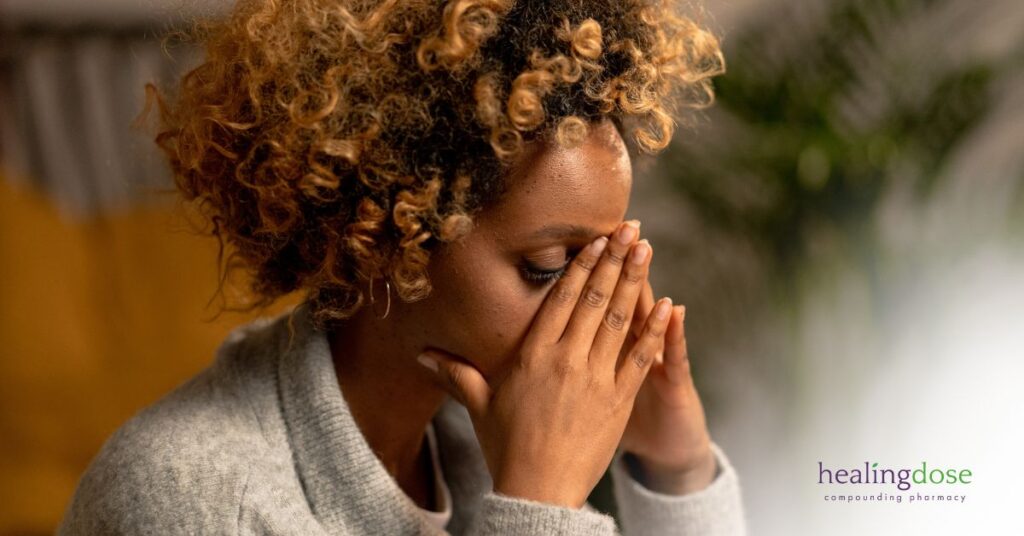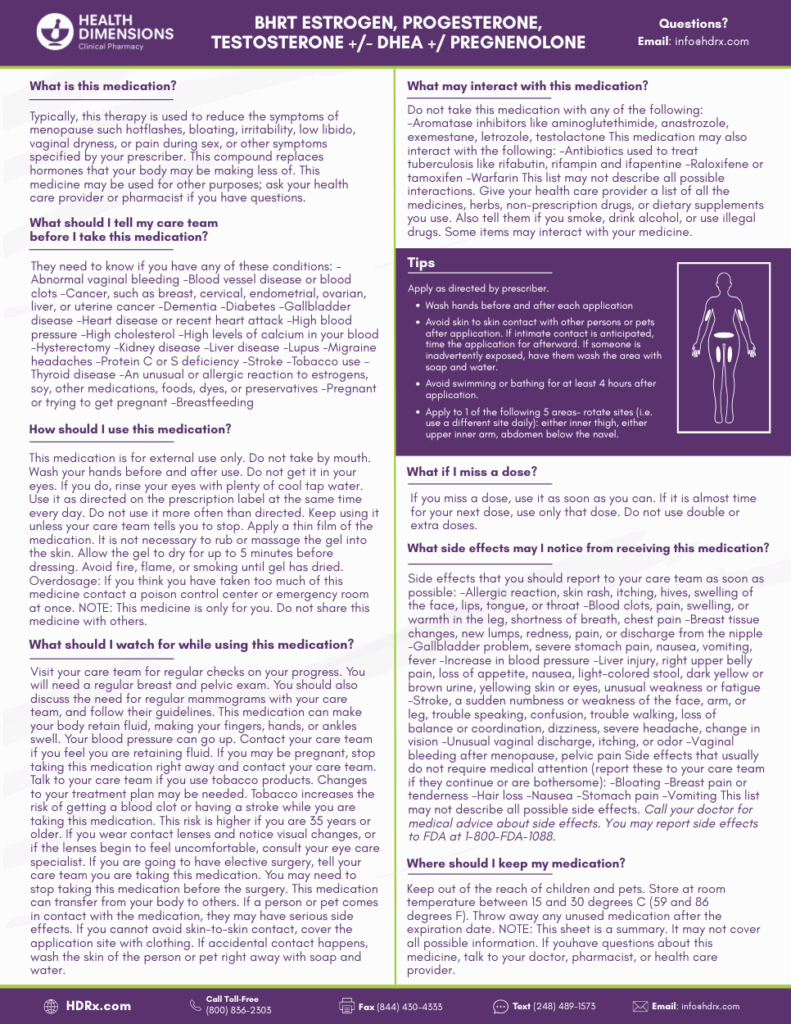A Closer Look at Personalized Testosterone Therapy with Compounding Pharmacy Support
This blog is Part 3 of a 4-part series on Bioidentical Hormone Replacement Therapy (BHRT), where we explore the most popular hormone therapy options prescribed for women with hormonal imbalances.
Need to catch up? Read Part I and II, and stay tuned for the next installment of our BHRT blog series: Progesterone
Understanding Testosterone Deficiency in Women
While testosterone is commonly associated with men, it plays a critical role in women’s health as well.
Testosterone is produced in the ovaries and adrenal glands and contributes to:
- Sexual desire and satisfaction
- Cognitive sharpness and mood stability
- Muscle tone and strength
- Bone health
- Energy and vitality
Levels decline with age, especially after menopause or oophorectomy. Studies show up to 50% of women over age 40 may experience symptoms associated with low testosterone, yet few receive appropriate testing or treatment.
In a pivotal randomized controlled trial, testosterone therapy was shown to significantly improve sexual function in postmenopausal women without increasing serious adverse effects (Davis et al., N Engl J Med, 2008).
Fatigue, Brain Fog, and Muscle Loss
It’s hard to fully understand the concept of BHRT, so let’s go through some unique ways compounded testosterone may help women.
Case Example #1
Sarah, a busy physician assistant and mother of three, came to her provider complaining of persistent fatigue, poor sleep, mental fog, and increasing abdominal fat despite exercising regularly.
Blood work revealed:
- Low free testosterone
- Low DHEA
- Normal estradiol and progesterone
Her provider chose testosterone cream 1 mg daily, compounded through HDRx, paired with micronized DHEA. Within 2 months, Sarah reported:
- Sharper memory
- Better stamina during workouts
- Noticeable improvement in her libido
- Decreased emotional volatility
Sarah’s case is common. Testosterone therapy may not be the first hormone considered — but it can be the missing puzzle piece when estrogen alone doesn’t resolve persistent symptoms.
Case Example #2
Julia had recurrent UTIs, vaginal dryness, and no interest in sex. She was offered systemic estrogen, which improved hot flashes but not intimacy. Her practitioner prescribed a vaginal estradiol 0.01% + testosterone 0.2% compound.
In just 3 weeks, Julia reported better lubrication and comfort during intercourse—no systemic side effects.
The case examples provided are for illustrative purposes only and do not reflect outcomes for any specific individual.
Why Bioidentical Testosterone from a Compounding Pharmacy?
Most FDA-approved testosterone products are designed for men. Even the lowest doses in gels or injections often exceed what is safe or appropriate for female patients. That’s where compounding may make all the difference.
Compounded testosterone at HDRx is available in female-specific microdoses such as:
- 0.25–2 mg topical creams
- 0.5–1 mg sublingual troches
- Vaginal microdoses (e.g., Estradiol 0.01% / Testosterone 0.2% vaginal tissue cream)
- Combination therapies with estriol/progesterone/DHEA as needed
HDRx supports prescribers in MI, FL, IL, IN, OH, WI, and MN with:
- Easy-to-use prescription order forms for BHRT, OB/GYN, urology, pain, and more
- Access to formulations tailored to female physiology, not male-based dosing
- Formulation flexibility: Creams, troches, vaginal applications, pellets
- Quick pharmacist consultation for dose titration or symptom-based changes
- Direct-to-patient delivery with cold-chain and temperature-sensitive shipping
Providers can use HDRx’s Female BHRT Order Form to easily tailor hormone protocols. It offers preset dosing options (0.5 mg, 1 mg, 2 mg, etc.) and checkboxes for combining hormones in custom ratios.
Each order form (e.g., Female Personalized Medicine Form) includes practical default options and the ability to combine hormones, reducing the burden on busy clinics.
Rx Order Forms are exclusive to approved practitioners.
Interested? Request access, now >>
Utilize our exclusive formula recommendations in our Rx Order Forms to provide your female patients with the best approach based on their specific symptoms and hormone test results.
Explore our Women’s Rx Order Forms
Female Personalized Medicine
Female Pain
Female Urology
General OB/GYN
When to Choose Compounded Bioidentical vs. Commercial Therapy
Compounded BHRT is a potentially better fit for:
- Perimenopausal or postmenopausal women with subtle but disruptive symptoms
- Commercial testosterone products are made in “male sized” doses. Women need lower doses of testosterone, achievable via a compounded medication.
- Allergy-sensitive individuals (e.g., peanut-free, dye-free formulations)
- Vaginal or topical application preferences
- Those with complex hormonal needs, e.g., combining estradiol, progesterone, testosterone, DHEA, and pregnenolone
Additional Clinical Considerations
When prescribing testosterone for women, monitoring is key. Suggested lab markers include:
- Total and free testosterone
- DHEA-S
- Estradiol, progesterone, and cortisol (if symptoms persist)
Patients should also be monitored for adverse effects such as:
- Acne or oily skin-avoidable with proper dosing
- Hair growth in unwanted areas-avoidable with proper dosing
- Mood changes (rare with proper dosing)
Clinical feedback, along with hormone tracking and symptom journals, helps prescribers optimize therapy and avoid adverse effects.
Empowering Female Patients with Better Tools
Testosterone therapy isn’t about “male hormones” in women — it’s about restoring what’s naturally declining. Many women feel dismissed when their symptoms don’t match “typical menopause” or fail to improve on estrogen/progesterone alone.
Compounded testosterone allows us to meet women where they are, with:
- Precision dosing
- Localized vaginal application for intimacy-related issues
- Troches for patients who dislike creams
- Safer dosing than male-based commercial options
Why Testosterone Matters
As more women advocate for personalized care, BHRT — including testosterone — is becoming a mainstream option for fatigue, low libido, cognitive sluggishness, and body composition struggles.
Providers who adopt bioidentical hormone therapy backed by compounding pharmacy support may have a meaningful way to help women reclaim their vitality.
Whether you’re a nurse practitioner managing menopausal symptoms, or a physician looking to expand into BHRT, HDRx offers tools, education, and reliable patient support every step of the way.
We ship prescriptions to MI, OH, IN, IL, FL, WI, MN
References:
Braunstein, G. D. (2012). Efficacy and safety of testosterone in the management of hypoactive sexual desire disorder in postmenopausal women. The Journal of Sexual Medicine, 9(4), 1134–1148. Link
Davis, S. R., Moreau, M., Kroll, R., Bouchard, C., Panay, N., Gass, M., & Braunstein, G. D. (2008). Testosterone for low libido in postmenopausal women not taking estrogen. The New England Journal of Medicine, 359(19), 2005–2017. Link
Davis, S. R. (2021). Use of testosterone in postmenopausal women. Endocrinology and Metabolism Clinics, 50(1), 113-124. Link
Files, J. A., Ko, M. G., & Pruthi, S. (2011). Bioidentical hormone therapy. Mayo Clinic Proceedings, 86(7), 673–680. Link
Islam, R. M., Bell, R. J., Green, S., Page, M. J., & Davis, S. R. (2019). Safety and efficacy of testosterone for women: A systematic review and meta-analysis of randomised controlled trial data. The Lancet Diabetes & Endocrinology, 7(10), 754–766. Link
Ruth, K. S., Cooper, R., Hardy, R., Wray, S., & Sayer, A. A. (2023). Impact of testosterone therapy on cardiovascular risk among postmenopausal women: A scoping review. Journal of the Endocrine Society, 8(1), bvad132. Link
Snyder, P. J., Bhasin, S., & Cunningham, G. R. (2019). Effects of testosterone therapy for women: A systematic review and meta-analysis protocol. Systematic Reviews, 8, 94. Link
Wierman, M. E., Arlt, W., Basson, R., Davis, S. R., Miller, K. K., Murad, M. H., & Rosner, W. (2014). Androgen therapy in women: An Endocrine Society clinical practice guideline. The Journal of Clinical Endocrinology & Metabolism, 99(10), 3489–3510. Link



